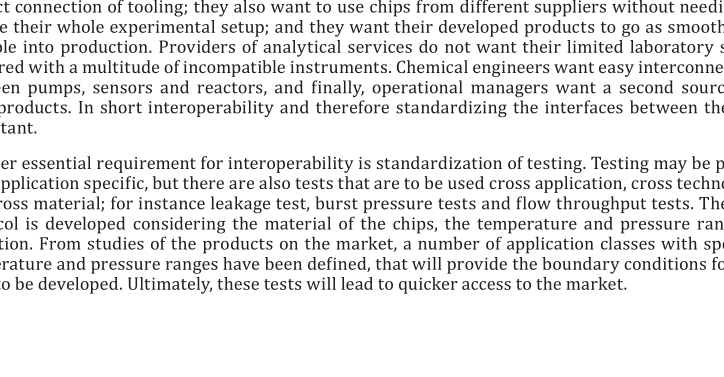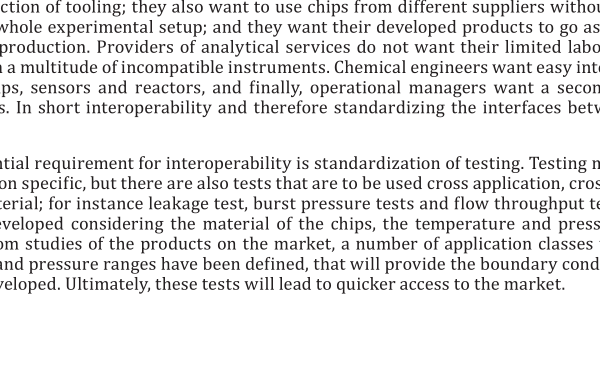ISO 22916:2022 pdf download – Microfluidic devices — Interoperability requirements for dimensions, connections and initial device classification.
1 Scope This document specifies requirements for the seamless integration with other microfluidic components and systems to facilitate the process of designing new microfluidic devices (e.g. microfluidic chips, sensors, actuators, connectors). This document is applicable to devices in the field of “microfluidics” needing microfluidic interconnections. 2 Normative references The following documents are referred to in the text in such a way that some or all of their content constitutes requirements of this document. For dated references, only the edition cited applies. For undated references, the latest edition of the referenced document (including any amendments) applies. ISO 10991, Micro process engineering — Vocabulary 3 Terms and definitions For the purposes of this document, the terms and definitions given in ISO 10991 apply. ISO and IEC maintain terminological databases for use in standardization at the following addresses: — ISO Online browsing platform: available at https:// www .iso .org/ obp — IEC Electropedia: available at https:// www .electropedia .org/ 4 General dimension tolerances Table 1 and Table 2 present the recommended general dimension tolerances regarding port pitches, chip thicknesses and port dimensions respectively for top connections and for side connections. In the tables and in the document n is an integer ≥1.
5.2 Naming of the chip The name of a rectangular (or square) chip shall contain information about the length and the width, defining an X-axis and a Y-axis. The X-axis shall be the direction with most of the fluidic connections. Then, the name of the chip shall contain X × Y with the correct values. EXAMPLE For a component of 15 mm by 30 mm with fluidic connections along the short length, the name of the chip contains at least 15 × 30. For example, “rectangular chip 15 × 30”. 5.3 Reference point The reference point is the intersection of the X-axis and the Y-axis. With the X-axis pointing from left to right, the reference point is at the top left of the chip as described in Figure 2.
6 Microfluidic chip dimensions 6.1 Chip thickness When made of glass, the microfluidic chip shall have a thickness compatible with existing standard wafer thicknesses since they are readily available and cheaper and no polishing is required. Moreover, standard wafers have an excellent surface quality, which has a positive influence in manufacturability and yield. When made of polymer, the microfluidic chip should have a thickness between 1 mm and 3 mm and the microfluidic film shall have a thickness between 100 µm and 250 µm. NOTE 1 The thickness is of relevance for side connection (see Clause 8). NOTE 2 The usual thicknesses for bottom layer, t 1 , and top layer, t 2 , are given in Table 3.
ISO 22916:2022 pdf download – Microfluidic devices — Interoperability requirements for dimensions, connections and initial device classification






